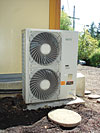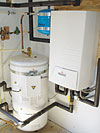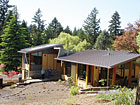
Flexible enough for installation types - in new or retrofit applications - Daikin Altherma can be connected to standard low temperature radiators, under-floor heating, and fan-coil units.
Now residents of the city’s Collins View neighborhood, when Baumann and Broussard initially began to have their new home built, their quest was to make it as sustainable, energy efficient, and eco-friendly as possible. This was not out of the ordinary for the area, however, the Altherma installation in the home turned out to be unique. So unique in fact, the homeowners have only half jokingly considered putting a guest book in their mechanical room. Combined with an eco-friendly heating and hot-water supply solution, these installations resulted in multiple tours of the home’s mechanical room.
“We are strong believers that living on this planet is a privilege and we need to be good stewards of it,” said Bauman. “Although we all have footprints we leave behind, we decided ours could be just footprints and not dents left on the environment.”
MANY DEMANDS, FEW SOLUTIONS
Bauman and Broussard interviewed several architectural firms, focusing on ones with green building expertise. They selected Constructive Form Architecture and Design LLC, a young, start-up firm whose members have environmentally supportive design experience throughout the United States and Europe.Brent Hinrichs, architect with Constructive Form, explained that the homeowners were intent on selecting as many green options as made sense. This involved extensive research and discussions since the design intent was “to use a minimal amount of energy and the most efficient - though not cost prohibitive - systems available, in conjunction with reducing the overall electric and heating loads for the project as a starting point,” said Hinrichs.
“The air-to-water heat pump was the preferred option … other- wise we would have been looking at a solar thermal preheat for a modulating electric boiler system given the goal of eliminating fossil fuel,” he recalled. Hinrichs and his Constructive Form co-owners, Simone Goldfeder, designer, LEED AP, and Kina Voelz, architect, LEED AP, discovered the Daikin Altherma which is an all-electric system with a variable-speed inverter type compressor providing a high coefficient of performance while delivering the sought after combined/integrated hydronic and domestic hot water functionality.
The design firm worked with the local Daikin AC office and when its officials approved the home as an introductory test-site for the continental United States, Daikin Altherma was specified.

The Daikin Altherma system consists of two main components (outdoor unit and hydrobox) that can also be combined with optional accessories such as a water tank and solar thermal kit to ensure ideal water temperature.
A NORTH AMERICA FIRST
The owners were fairly active in the design of the home, and at one point seriously considered using only a wood stove for heating. But they didn’t like the idea of starting a fire each morning for warmth. “We knew we wanted in-floor radiant heating, but we never really had to pursue other brands of systems, thanks to the guidance from our architect-design firm,” said Bauman.With the Altherma system chosen and final plans approved, construction began on the new home. The HVAC contractor selected for the job, Jacobs Heating & Air Conditioning, is the Portland area’s largest Daikin Network Alliance (DNA) partner. The company had extensive experience with other Daikin products that proved to be helpful in the installation of this new system. The radiant heating system, which has four zones and runs throughout the 1.5-story, 1,820 square-foot home, was one of the first aspects of the mechanical system to be installed.
Brian Erdahl, lead technician at Jacobs, explained that all of the radiant floor tubing was run to the remote manifolds in the walls and some panel radiators were oversized, so the Btus needed could be matched with 120°F water. Next, the contractor ran supply and return feed lines to the mechanical room to supply the radiant floor and panel heaters in four separate zones. After the plumber installed the plumbing lines and everything was roughed in, the Daikin Altherma outdoor unit and the Hydrobox - Daikin’s indoor unit containing the refrigerant/water heat exchanger - were set for installation. A heat recovery ventilator was also installed to control the fresh air entering the house and works hand-in-hand with Daikin Altherma. According to the company, this combination creates outstanding efficiency and air quality.
While there were some European to United States voltage and metric to standard conversion challenges, all were overcome fairly quickly and easily. Additionally, Jacobs had to work with the city of Portland for approval of the unit since there was an ETL listing, but no applicable AHRI testing and rating program. But, Erdahl said the city officials “were more than happy to let a system this efficient go into a home in the Portland area and they were great to work with.”

The Bauman-Broussard home, which received a LEED Platinum rating, is the site of the first installation of a Daikin Altherma in North America.
EFFICIENCY UNDER CONTROL
Daikin Altherma provides the ability to intricately monitor and manipulate system performance, and features an automatic control system adjusting the system’s operation to varying ambient conditions. It can basically be tuned to suit the homeowner’s exacting requirements, and also features an automatic restart feature in the event of a power interruption. Additionally the system can be equipped with a back-up heater (in a refurbishment type application, it can reuse an existing boiler installation) that can be used for supplemental heating during extremely cold outdoor temperatures or as a backup to the outdoor unit.The home’s control system was set up so the thermostat calls for heat, opens the valve, and turns the circulation pump on, but the pump will only run when necessary. Thus, the homeowners are not paying for the pump to check water temperatures when they are in the non-heating season. The Altherma operates as low as 49 dBa and can be set to produce 10 dBa less noise during the night.
In addition to Daikin Altherma and a host of other eco-friendly initiatives - such as installation of a 2.4 kW solar photovoltaic system - the homeowners are selling power back to the grid, and providing all of their domestic hot water with the use of Daikin Altherma via the solar photovoltaic panel array.
The house was also pre-plumbed for future solar thermal inputs and there is a potential for using a reverse-cycle to provide chilled water for partial tempering of the floor during cooling season.
Efforts such as these earned the home LEED Platinum certification under the U.S. Green Building Council’s LEED for Homes Pilot Program. This certification hinged on several components, but Daikin Altherma played an instrumental role.
For more information, visit www.daikinac.com or call 866-4DAIKIN.
Sidebar: Green Elements
Other Featured Eco-Friendly Applications:• Low-VOC paint and formaldehyde-free glues
• Recycled paper and resin countertops
• Compact fluorescent lights
• Solar-powered landscape lighting
• Pervious concrete driveway
• 100 percent of storm water treated onsite
• Reflective metal roof
• Rainwater collection for site irrigation
• Flow-through planters
• Site restoration
• Native landscaping
• Highly efficient plumbing fixtures.
Sidebar: Product Specs
Daikin Altherma™ is a system that heats, produces domestic hot water, and is capable of cooling spaces. It delivers maximum comfort the whole year through and can be an alternative to conventional gas or fuel oil heating.The air-to-water heat pump uses a sustainable energy source and extracts heat from the outside air. The system consists of a closed circuit containing R-410A refrigerant. A thermodynamic cycle is created through evaporation, condensation, compression, and expansion.
Depending on the model and the conditions, the Altherma air-to-water heat pump delivers between 3 and 5 kWh of usable heat for every 1 kWh of electricity it uses. It can be configured for use in both new and refurbishment applications, and connects to standard low temperature radiators, under floor heating, or fan coil units. In combination with a solar thermal set-up, it uses thermal energy from the sun to raise the temperature of domestic hot water, cutting on both CO2 emissions and operating costs.
Publication date:02/22/2010

Report Abusive Comment